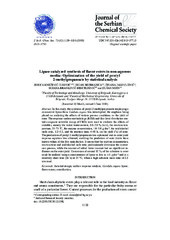Приказ основних података о документу
Sinteza mirisnih estara katalizovana lipazama u nevodenoj sredini - optimizacija prinosa pentil-2-metilpropanoata statističkom analizom
Lipase catalyzed synthesis of flavor esters in non-aqueous media: Optimization of the yield of pentyl 2-methylpropanoate by statistical analysis
| dc.creator | Knežević-Jugović, Zorica | |
| dc.creator | Bezbradica, Dejan | |
| dc.creator | Jakovljević, Živana | |
| dc.creator | Branković-Dimitrijević, Suzana | |
| dc.creator | Mijin, Dušan | |
| dc.date.accessioned | 2022-09-19T16:12:39Z | |
| dc.date.available | 2022-09-19T16:12:39Z | |
| dc.date.issued | 2008 | |
| dc.identifier.issn | 0352-5139 | |
| dc.identifier.uri | https://machinery.mas.bg.ac.rs/handle/123456789/842 | |
| dc.description.abstract | U radu su ispitani uticaji različitih procesnih parametara na sintezu pentil-2-metilpropanoata katalizovanu lipazom iz Candida rugosa. U cilju optimizacije enzimske sinteze estara primenjena je metodologija odzivnih površina u skladu sa odabranim centralnim kompozicionim rotabilnim planom (pet faktora na pet nivoa). Ispitani su uticaji procesnih parametara na prinos estra u sledećim intervalima: početnog sadržaja vode (0,0-2,0 %), temperature (35-75°C), koncentracije enzima (1,0-5,0 g dm-3), početnog molskog udela supstrata (1:2-5:2) i reakcionog vremena (4-48 h). Dobijen je adekvatan matematički model na osnovu koga se može predvideti ponašanje sistema u funkciji ovih pet faktora. Pokazano je da koncentracija enzima, početni molski odnos supstrata i reakciono vreme imaju najveći uticaj na proces, dok sadržaj vode ne utiče značajno na prinos estra. Pod optimalnim uslovima enzimske sinteze ostvaren je prinos estra oko 92%. | sr |
| dc.description.abstract | In this study, the synthesis of pentyl 2-methylpropanoate employing a commercial lipase from Candida rugosa was investigated, the emphasis being placed on analyzing the effects of various process conditions on the yield of ester. The response surface methodology (RSM) and five-level-five-factor central composite rotatable design (CCRD) were used to evaluate the effects of variables, namely the initial water content, 0.0-2.0% (w/v), the reaction temperature, 35-75°C, the enzyme concentration, 1.0-5.0 g dm-3, the acid/alcohol mole ratio, 1:2-5:2, and the reaction time, 4-48 h, on the yield (%) of ester. The production of pentyl 2-methylpropanoate was optimized and an ester yield response equation was obtained, enabling the prediction of ester yields from known values of the five main factors. It seems that the enzyme concentration, reaction time and acid/alcohol mole ratio predominantly determine the conversion process, while the amount of added water amount had no significant influence on the ester yield. Conversion of around 92 % of the substrate to ester could be realized using a concentration of lipase as low as 4.0 g dm-3 and in a relatively short time (26 h) at 35°C, when a high substrate mole ratio of 2.5 was used. | en |
| dc.publisher | Beograd : Srpsko hemijsko društvo | |
| dc.relation | info:eu-repo/grantAgreement/MESTD/MPN2006-2010/20064/RS// | |
| dc.rights | openAccess | |
| dc.rights.uri | https://creativecommons.org/licenses/by-nc-nd/4.0/ | |
| dc.source | Journal of The Serbian Chemical Society | |
| dc.subject | surface response analysis | en |
| dc.subject | flavor esters | en |
| dc.subject | factorial design | en |
| dc.subject | esterification | en |
| dc.subject | Candida rugosa lipase | en |
| dc.title | Sinteza mirisnih estara katalizovana lipazama u nevodenoj sredini - optimizacija prinosa pentil-2-metilpropanoata statističkom analizom | sr |
| dc.title | Lipase catalyzed synthesis of flavor esters in non-aqueous media: Optimization of the yield of pentyl 2-methylpropanoate by statistical analysis | en |
| dc.type | article | |
| dc.rights.license | BY-NC-ND | |
| dc.citation.epage | 1151 | |
| dc.citation.issue | 12 | |
| dc.citation.other | 73(12): 1139-1151 | |
| dc.citation.rank | M23 | |
| dc.citation.spage | 1139 | |
| dc.citation.volume | 73 | |
| dc.identifier.doi | 10.2298/JSC0812139K | |
| dc.identifier.fulltext | http://machinery.mas.bg.ac.rs/bitstream/id/2698/839.pdf | |
| dc.identifier.scopus | 2-s2.0-57349160465 | |
| dc.identifier.wos | 000262014900001 | |
| dc.type.version | publishedVersion |


